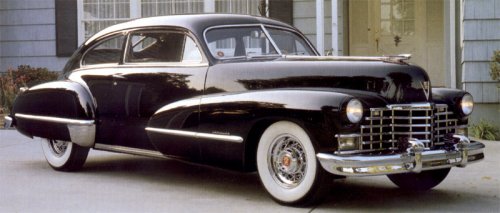
1946 Cadillac Sedanet
Ending a hurried production run that had begun four years earlier, just after Pearl Harbor, the last M-24 tank rolled off the Cadillac assembly line on August 24, 1945. Amazingly, the first '46 Caddy was produced on October 7, 1945.
By necessity, the '46 Cadillac was a quickly thrown-together rehash of what Cadillac had offered in 1942, and only Series Sixty-Two four-door sedans were built at first. Cadillac ads made much of the fact that their "Battle-Proved" engines and transmissions were the only automotive components continually produced without interruption during the war, and improved along the way to boot. A major modification, however, was the adoption of a negative battery ground.
Styling changes were minimal, though noticeable. Rectangular parking lights resided on the upper portion of the slightly modified grille (with fewer vertical bars), and wraparound bumpers were adopted front and rear. The front of the hood and the decklid now sported the Cadillac crest nestled in a "V," which would become a long-standing trademark, so the Cadillac block lettering was moved to the front fenders.
Model offerings were pared to just 11 for 1946. Gone entirely were the Series Sixty-Three and Sixty-Seven, while the Sixty Special lost its division-window model, as well as the vertical chrome strips on the fenders. The latter were replaced by five hash marks on each C-pillar. Series Sixty-One and Sixty-Two continued with the coupe and sedan, and the later boasted the only convertible in the lineup as since 1941. The Series Seventy-Five, meanwhile, was pared to five models, down three, although five-, seven-, and nine-passenger models were still listed, as were the Imperial models with divider windows. Seventy-Fives traded the hood louver decorations and triple fender speedlines of '42 for an almost full-length chrome strip starting at the front of the hood, and gained stainless steel running boards. Cadillac block lettering was moved to the lower front fenders.
Strikes and materials shortages, particularly of sheet steel, were major industry-wide problems during the '46 production year. Thus, some Cadillacs went through the assembly lines with only brackets to hold temporary wooden bumpers -- the real ones had to be installed by dealers as they became available later.
Pressure on Cadillac to produce was intense. Even in 1947, there were still almost 100,000 unfilled orders for what one division sales manager, D. E. Ahrens, called ". . . one of the most sought-after, and most scarce items in the world today." People knew Cadillac's value and prestige, and that was what they wanted, but due to the early postwar difficulties only 29,214 customers got to drive a '46 Caddy home.
And those that managed to get one paid for the privilege, as the price-leader Sixty-One fastback now started at $2052, up a whopping 41.5 percent over 1942. The Business Imperial nine-passenger sedan, the most expensive 1946 offering, listed at $4346, up $1266, or 41.1 percent. Of course, pricing was a problem for all automakers in the inflationary days following the war.
In 1946 four models were offered:
1946 Cadillac Notes